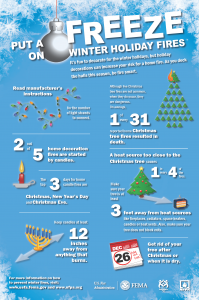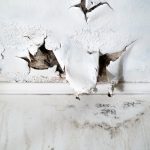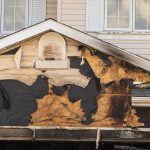5 Holiday Fire Safety Myths
Nearly 47,000 fires occur during the winter holidays claiming more than 500 lives, causing more than 2,200 injuries, and costing $554 million in property damage. Candle fires are four times as likely during the holiday months. During the winter holiday season, an average of 40 home fires per day are caused by children playing around the home. All of these are facts and need to be considered when preparing your home for the holiday season. Let’s talk about some of the most common myths about fire safety around the holidays.
Myth 1: Christmas Trees Are The Number 1 Cause Of Holiday House Fires
According to the National Fire Protection Association (NFPA), 0.12% of residential fires involve a real or artificial Christmas tree. By comparison, the following household items are much more likely to ignite a fire:
- Boxes or Bags (10 times more likely)
- Newspapers & Magazines (13 times more likely)
- Curtains or Drapes (9 times more likely)
A real tree can be a safe bet, but ensure the freshness of the cut tree. A fresh tree still contains a lot of moisture and is extremely difficult to ignite. (If you bend the branch, does it bounce back into place? The fresher the tree, the more supple the branches and the faster they will bounce back.) Christmas trees do not spontaneously combust and they do not start house fires. A properly maintained Christmas tree is not a fire hazard. By practicing some basic safety precautions, you can safely enjoy a real or artificial Christmas tree throughout the season.
Myth 2: Holiday Fires Only Occur Due To Christmas Trees, Electrical Issues & Fireplaces/Candles
Holiday cooking is quickly becoming one of the leaders in holiday fire instances. Cooking fires are the primary cause of home fires and home fire injuries. The majority of cooking equipment fires start with the ignition of common household items. One such cause is the use of deep fryers for cooking turkeys. According to the National Fire Protection Association, each year deep fryer fires cause an average of:
- 1,000 home fires
- 3X the fire damage of other forms of cooking
- 5 deaths, 60 injuries and more than $15 million in property damage
Other fires from the kitchen are equally damaging. With busy homes and family and friends visiting it can be easy to leave cooking food unattended, letting children too close to hot surfaces and being generally careless with dangerous appliances. Below are a few safety tips:
- Keep cooking areas clean and clear of combustibles (i.e. potholders, towels, rags, drapes and food packaging).
- Never leave cooking food on the stovetop unattended, and keep a close eye on food cooking inside the oven.
- Turn pot handles inward so they can’t be bumped and children can’t grab them.
- Keep children and pets away from cooking areas by creating a three-foot “kid–free zone” around the stove.
- Wear short, close fitting or tightly rolled sleeves when cooking. Loose clothing can dangle onto stove burners and catch fire.
- Never pour water on a grease fire and never discharge a fire extinguisher onto a pan fire, as it can spray or shoot burning grease around the kitchen, thus spreading the fire.
- If there is an oven fire, turn off the heat and keep the door closed to prevent flames from burning you and your clothing.
- If there is a microwave fire, keep the door closed and unplug the microwave. Remove the lids or other coverings from microwaved food carefully to prevent steam burns.
Myth 3: You Have About Five Minutes To Escape A House Fire
Once a fire starts, get out immediately. A small flame can turn into a major fire in less than 30 seconds. A home fire can double in size every minute. In three minutes, a fire can burn so hot that it ignites everything at once. (This is called a flashover). Typically this type of quick-moving fire is caused by incredibly hot items like turkey fryers but can be ignited by burning embers in a fireplace or even holiday candles. Hot coals inside a fireplace can continue to produce heat in excess of 200 degrees – hours after they appear to be burnt out. Many fires that can lead to fire damage inside a home are triggered by candles that drip hot wax or candle residue onto these flammable coverings. Other causes of indoor fires can be caused by candles that are near other combustible materials such as:
- Decorative tissue paper
- Wooden toys or holiday decorations
- Oils or potpourri
Myth 4: A Smoke Detector Can Provide Enough Protection During A House Fire
Smoke detectors save lives by providing an early warning to a smoke or fire incident, but can do nothing to extinguish a growing fire. They also do little to protect those physically unable to escape on their own, such as the elderly or small children. Increasingly often, battery operated smoke detectors fail to function because the batteries are dead or have been removed. As the percent of homes in America that were “protected” with smoke detectors increased from zero to more than 70%, the number of fire deaths in homes did not significantly decrease. A home needs more than just a set of functioning smoke detectors. Families need an escape plan, fire extinguishers, and certain circumstances even a sprinkler system.
Myth 5: Christmas Tree Lights Cause House Fires
Today’s Christmas tree lights come standard with safety fuses in the plugs to ensure excited decorators don’t overwhelm the electrical circuits in individual wall sockets. Christmas lights alone cannot increase the likelihood of holiday fires, however, outdated lights with no safety fuses can lead to issues. When a Christmas tree is loaded down with too many lights and using extension cords and several wall outlets, a Christmas tree can reach temperatures of up to 200 degrees and become a danger to the homeowners.
Christmas lights alone aren’t a fire hazard by themselves. However, holiday goers should still avoid overloading extension cords and electrical sockets with strands upon strands of lights in case of a short circuit. If the resulting spark lands on a Christmas tree branch, the whole thing could quickly go up in flames. Other tips to help avoid Christmas tree-related fires:
- Keep your tree at least 6 feet away from fireplaces
- Avoid overloading sockets and extension cords with holiday lights and decor
- Be sure to turn lights off when you leave your home
- Ensure stockings and presents don’t rest too closely to candles or fireplaces
- Be sure to keep your tree watered if you have a real tree to keep it from drying out
In Summary
The holiday season is a time of year for reflection, celebration and spending time with those you love. Worrying about fire damage or the destruction of your home shouldn’t be a fear to grapple with. Ensure your loved ones’ protection by implementing a fire safety plan at the holidays and be mindful of the tips above. For a handy-visual guide view the tips from FEMA below.



